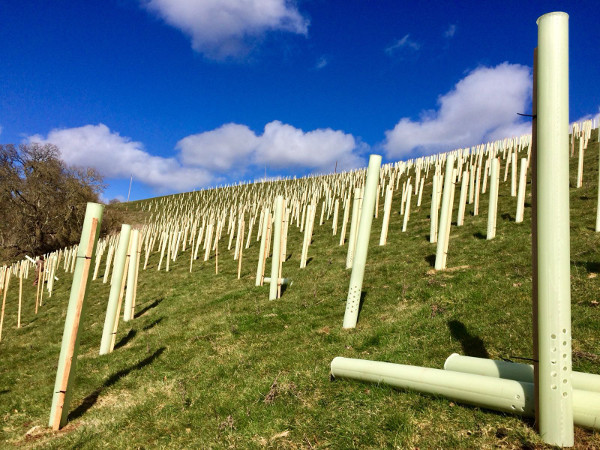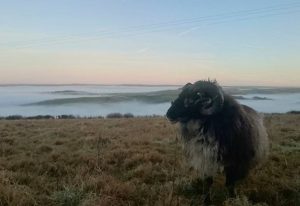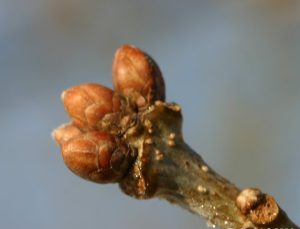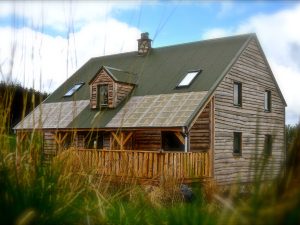During winter, while the animals hibernate and the trees sleep, magic happens on hillsides across the land – forests are created! A brief account of the ups and downs of life for a tree planter this winter… creating a woodland on a farm in Devon.
Tree planting happens in winter while the sap is down in the roots, giving trees time to settle in before the growth of spring and summer arrives.
Our task was to plant 5,200 trees, with stakes and 1.5m high guards – to protect them from rabbits and deer.

Trees waiting in their nursery… Hazel, Oak, Beech, Birch, Hornbeam and more…
Day 1
I stand at the top of the hill and look down. It looks massive and steep. I can’t imagine how the team and I will fill it with trees in the time we have, before the sap rises and the window of winter tree planting is over. Feeling rather daunted, yet excited.

The blank canvas – a Devon farm hillside ready to become a forest. (It’s steeper than it looks!)
It’s been a whole year since I took part in the rhythmic flow of tree planting. Spade in, slot open, tree in, spade out, kick ground closed, move to next space, spade in… the rhythm and repetition of a tree planter.
Day 2
This isn’t so bad. The only access for us and all the gear is at the top, and so in these first few days it’s not so difficult, we are still up at the top of the hill. Every now and then I lift my head from the trees and look down the hill. I try not to do that too often. It’s a daunting sight.

A grey day on the hill… we begin, one planting, one hammering, one guarding.
We stake and guard each tree – no tree left unguarded, even for one night. I have images of swathes of rabbits and herds of deer coming out at dusk to inspect our work and seek out any forgotten unguarded trees for a tasty snack.
Day 3
My big toes stung in the shower this evening. Having kicked the ground repeatedly hundreds of times these last few days, kicking the tree slot closed, I think I have a syndrome I’ll call ‘tree-planter’s toe’. I finish the day with aching toes and make a resolution to try heel kicks next week.
Day 4
I dreamt of tree planting last night, we had forgotten to guard a tree. It stood lonely and vulnerable in the field.
I think this tree planting thing has got to me.

Blessed with blue skies… sometimes!
Day 7
I eat at least double my normal amount on a day I’m tree planting – my lunch fills my rucksack. I walk back to the cars with an empty bag.

A whip – a young tiny tree – all we have to do is make a slit in the ground and slide it in, keeping the roots going straight down, and closing the gap.
Day 9
We pass a roadkill deer on the way to work early this morning. I pull in and we haul it into the car. It is so fresh, must have been less than an hour since it was walking through the forests that the road runs through.
I gut it in the field before work and give thanks for its life – its meat will feed us hungry workers and its skin I will tan.
Later that day I’m hammering in stakes and I absentmindedly hit my finger with the sledge hammer. It hurts a little and I take a look. I’ve smashed my finger open in the impact and have to have a sit down from the shock of looking at the state of my finger, all blood and smashed skin and a worrying numbness. I feel like sometimes life requires something from me after such a big gift of the deer. My blood for his blood.
I sit out the next hour while my finger throbs.
Day 10
We try to plant but the ground is so hard I can’t kick the tree slot closed. It’s frozen and dry and the ground is solid.
Instead we haul stakes down to the bottom of the hill, then walk back up again. Repeating this tens of times requires something more than just strong leg muscles. There’s an element of willpower needed to climb that hill, again and again.

As the days go on, my world becomes this, spade in, spade out, tree in… move on…
Day 11
Snow. Huge drifts and swathes have fallen in the night. Even if we could get there on the roads, I doubt we could do much planting.
A much needed extra day off to play in the snow.
Day 14
We are planting in rows, and in a pattern. Clumps of Oak surrounded by Birch, Beech and Hornbeam. The faster growing trees will help create straight-trunked Oak, perfect for harvesting the timber and building homes in the future. I love that the foresters of today think of the foresters of tomorrow. We won’t see the buildings that these Oaks become, but we reap the benefits of a well thought-out planting plan from 80 years ago. Trees help me think long term, and encourage my altruism.
We took some time to work out the pattern… what each row must contain in order to tessilate the design… and now I see it everywhere I go. If I see dots on a page I think to myself – Oak-Oak-Birch-Oak-Oak-Beech-Oak-Oak-Birch…

We lay the stakes out ahead – horizontal and vertical creating our pattern. A code for the planters coming behind. Here an Oak, here a Beech, here a Wild Cherry…
Day 15
Realise that the further down the hill we get, the more time everything takes. We’ve started bringing our lunches down, as the daunting sight of walking up the hill for break is too much after hours of planting and hammering.

We contemplate the plan of action… for the final few rows.
Now, as I stretch my neck up from the trees I look up with satisfaction and a sense of achievement. We are nearly there.
Day 17
And that joyful moment arrives – the last tree.

The last tree finally is planted, ready with stake and guard waiting to shelter it.
We talk about a woodland picnic reunion in 30 years time – we are the weary and proud creators of a forest. It feels like something big, yet simple.
Yet all we leave for now is a field full of plastic tubes sheltering a baby forest.

A satisfied planter heads home after a day on the hill.







7 Comments
That’s a fantastic effort – just putting 100 trees in nearly did for me! Curious as to why you staked them – usually young whips are fine even in windy spots and the latest advice is not to stake to make the tree establish a good root system.
Hope your finger got better – sounds nasty!
Jessie what a fantastic achievement, congratulations ????
How much did it all cost?
Thanks – it was a big job and I didn’t do it alone, that’s for sure!
The stakes are to hold the guards up, the tree stands inside the guard unattached… yes I too understand that it is best to let a tree develop a strong root system without a stake, though I imagine they are useful for some larger trees in really windy spots.
Finger recovering thanks!
And I was working for someone else, so I don’t know the total cost. It was funded by the Woodland Trust – I think they pay around 60% of all costs.
How wonderful to be involved in that! How did you get involved?
It’s my job… for the last 5 winters.
I’d had lots of tree planting experience as a volunteer before working for the forester I work for… which I think really helps.
hi there, i enjoyed reading this post! it will be a great habitat for wildlife in years to come!
I plant in Scotland – we had a great job last sept in the highlands 56,000 deciduous natives in a very large Fenced area, we used canes and a vole guard with every tree. Any Deer or Hares within the fenced area are dealt with by the estate gamekeepers.
We had a similar situation to you in that our Materials drop was at the top of the hill. I personally did quite alot of Riparian planting and had a fair hike just to refill my planting bag.
If you would like to keep in touch with me in regards to planting and contracts my e.mail is [email protected]
sincerely -martin
interesting to see the air holes low down on tree guards… this is long overdue
p.s – everyone develops there own style but personally i heel the trees in rather than Toe ! 🙂